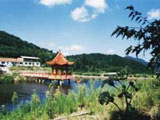 Situated in the southeast of Jilin Province and surrounded by mountains, the city of Tonghua is blessed with a large number of scenic attractions and historical remains.
Situated in the southeast of Jilin Province and surrounded by mountains, the city of Tonghua is blessed with a large number of scenic attractions and historical remains.
Tonghua is located at the southern foot of the Changbai mountains and faces North Korea across the Yalu River in the south. It’s a major transportation hub between northeast China and the Korean Peninsula, and one of the country’s three border port cities to North Korea.
It’s widely known in China that the Chongqing Municipality in the southwest of the country is nestled among mountains and famous for its steep winding streets. In fact, parts of Tonghua are very similar in this regard: the old quarter is fairly flat, but some of other places – well, make sure you’re in good shape if you want to get around by bike, because two thirds of the area is covered with imposing mountains. As a result, one of the city’s main attractions is its spectacular mountain scenery.
Tonghua has five state-level forest parks and a large number of mountainous scenic areas. One of the most famous is the Five-Fairy-Peaks Forest Park, tucked away deep in the southwestern part of the meandering Changbai Mountains. The place derives its name from an ancient legend that tells of how the five beautiful peaks in the park were formed by five pretty fairy sisters who were so attracted by the splendid scenery of the Changbai Mountains that they descended from heaven to see them at first hand.
The five peaks are all covered with verdant forests, and each of them presents a different but very enchanting sight. The highest peak is said to have been made by the eldest sister, who endowed it with many rare plants and medicinal herbs. Climbing to the top, visitors can enjoy a bird’s-eye view of the whole park. The lowest peak is the most beautiful of all, and said to have been created by the youngest and prettiest fairy.
These picturesque mountains are dotted with many scenic spots, including grand valleys, majestic waterfalls, limpid pools, deep caves and exquisite stone sculptures carved over the ages by Mother Nature.
It is often said that where is a mountain, there is water. This is certainly true of Tonghua. The mountain-girt city is crisscrossed with numerous rivers, lakes and pools. One good place to go is the Longgang Crater Lakes Scenic Area in Huinan County. The area boasts one of the largest groups of extinct volcanoes in the country. After the volcanoes erupted some 200 thousand years ago, underground water gradually rose and filled the craters, forming six lakes of different shapes and sizes. Seen from above, they are as shining pearls midst the emerald green forest-covered Longgang Mountains.
In addition to its scenic beauty, Tonghua is also known nationwide as the home of that truly amazing medicinal plant, ginseng. The area’s history of ginseng cultivation goes back several hundred years, and now its output of this root accounts for some 40 percent of the country’s total. In ancient times, Tonghua was a major gateway to the Changbai Mountains, the most important source of wild ginseng. The ancient “ginseng road” is still there, allowing people today to retrace the footsteps of generations of local people who braved the deep forests in search of ginseng.
The famous ginseng road starts from the tomb of Sun Liang, seven kilometers northwest of the city center. Sun Liang is believed to be the first person to dig ginseng in the deep forests of the uninhabited Changbai Mountains, and for centuries he has been regarded as the guardian of the local ginseng gatherers. In the past, before people entered the mountains to look for ginseng, they would first burn incense before his tomb and pray for blessings.
From Sun Liang’s tomb visitors can follow the ginseng road along the Lagu River to the Changbai Mountains. On the way you can find some other tourist attractions, such as the Wanwanchuan Holiday Resort, Tonghua Deer Park, the Jindou Korean and Manchu Ethnic Village, and the Yinggebu Reservoir.
For people interested in history and culture, the ancient town of Ji’an in southern Tonghua is a must-see. Some two thousand years ago, Ji’an served as the capital of the Koguryo Kingdom for more than four centuries, and left behind a great number of historical sites and artifacts, including a complex of some 12,000 mausoleums, as well as city walls, palace ruins, gate towers, tomb murals and steles.
Unfortunately, Tonghua is currently not accessible by air. But don’t worry! It has convenient rail and highway links with all major cities in northeast China. And there are a dozen star-rated hotels to ensure you a delightful stay in the city.
(CRI January 22, 2003)
|

